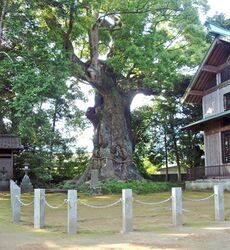Biology:Shinboku

The term shinboku refers to trees and forests as himorogi in Old Shinto, as well as shintai. A tree is a tree, a forest, a shintai, a yorishiro, a Shinto shrine, a warding. It is also called goshingi.
The term goshingi refers to trees that are considered sacred or divine in the precincts of Shinto shrines and List of Jingūs of Shintoism, as well as the forests that surround them and trees that are not logging. It also refers to trees that are owned by shrines or by private individuals and have a special origin in folklore. It may also refer to trees that have been specially cut down for planting or growing wild to be used as timber for the construction of shrines.
Overview
The nature worship called Himikura Shinto is also a part of the ancient Shinto religion. Out of gratitude, fear, and respect for God, life, and nature, symbolic objects in places where the environment changes were used as Shinto bodies, not limited to trees. symbolic objects in places where the environment changes, including but not limited to trees, as Shinto bodies. In the thousands of years that have passed since this ancient Shinto, the form and style of shrines as vessels and rituals as inner life have been influenced by foreign religions or established independently, becoming Shinto shrines and other forms of Shinto.
Most of the tens of thousands of Shinto shrines in Japan were originally built on the site of Shinto shrines in the ancient Shinto religion, and this is why there are sacred trees as Shinto shrines, sacred stones (rocks) as sacred trees, iwakura rock sects, steles and mounds exist and are enshrined in the precincts. Some shrines do not have shrines at all, but enshrine sacred trees as their sacred bodies, and some shrines do not have shrines at all, but enshrine sacred trees in their natural state.
In some places, there is no shrine, but the sacred tree in its natural state is worshiped by many people. Evergreen trees with pointed branches are often used in Shinto rituals as tamagushi, a substitute for the gods to descend from. The most common type of skewer is sakaki, but since sakaki does not grow naturally in the north of the Kanto region, hisakaki and ogatama no ki (sacred tree) are sometimes used. Ogatama no ki are sometimes used. In general, a tadakushi indicates a branch that has been cut down to be offered to the gods, while a sacred tree is one that is still rooted in the earth.
Yorishiro
Kami-yorigi, kanjinboku, etc. are considered to be yorishiro of the gods, and are given special treatment in shimenawa. The Nageia nagi is a yorishiro of the gods, and is given special treatment in shimenawa. Many of them are Nageia nagi, mochinoki, and cedar.
In addition, some trees are treated as sacred trees, such as the cedar trees at Ise Grand Shrine, which are regarded as special trees separate from the gods in order to maintain the scenery or create a solemn atmosphere. For those who work in the mountains, a tree that stands out as a substitute for the god of the mountain may be temporarily treated as a sacred tree and enshrined.
The gohei, which is used in Shinto rituals and is made from sakaki and nagi, is also called a sacred tree, but it was originally a simple substitute for a naturally occurring sacred tree in ancient Shinto.
Divine realms and boundaries
In ancient Shinto, the Shinto shrine was considered to be a Shinto shrine as a place where the gods dwelled, or a boundary between the everlasting world and the present world, and was feared and respected. In order to prevent people, things in this world, gods in this world, and things that bring misfortune and evil to this world from easily coming and going, shimenawa were hung as walls, making it a forbidden place. Even today, there are many places such as Okinoshima Island where not only the shrine, the sacred tree, or the forest of the local guardian, but the entire island is forbidden. In some places, rituals and festivals are held for a certain period of time when people want to bring good fortune and invite the gods in.
Tradition
Refers to a tree with a special origin, such as in a folk tale. In addition, trees that were written about in poems by famous poets are treated as sacred trees. There are many trees such as the plum trees at Dazaifu Tenmangū that were written about by poets.
Memorial tree
Trees donated by people who are related to the shrine are considered sacred and are treated as sacred trees.
Construction tree
When building a shrine, the trees that will be used for its lumber are treated as sacred trees.
See also



